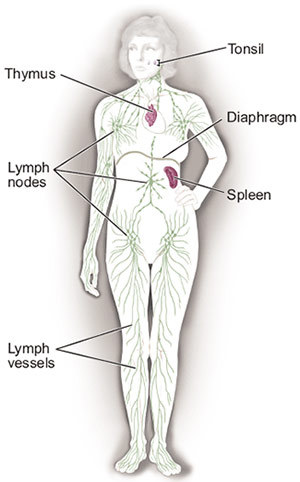
The lymphatic system is part of the immune system. The lymphatic system includes lymph vessels that branch into all the tissues of the body; lymph, clear fluid that contains white blood cells, especially lymphocytes such as B cells and T cells; and lymph nodes, where lymph vessels are connected to small, round masses of tissue. Groups of lymph nodes are found in the neck, underarms, chest, abdomen, and groin. Lymph nodes store white blood cells. They trap and remove bacteria or other harmful substances that may be in the lymph.
There are many different types of non-Hodgkin lymphoma. These types can be divided into aggressive (fast-growing) and indolent (slow-growing) types, and they can be formed from either B-cells or T-cells. B-cell non-Hodgkin lymphomas include Burkitt lymphoma, chronic lymphocytic leukemia/small lymphocytic lymphoma (CLL/SLL), diffuse large B-cell lymphoma, follicular lymphoma, immunoblastic large cell lymphoma, precursor B-lymphoblastic lymphoma, and mantle cell lymphoma. T-cell non-Hodgkin lymphomas include mycosis fungoides, anaplastic large cell lymphoma, and precursor T-lymphoblastic lymphoma.
Other parts of the lymphatic system include the tonsils, thymus, and spleen. Lymphatic tissue is also found in other parts of the body including the stomach, skin, and small intestine. Because lymphatic tissue is in many parts of the body, lymphoma can start almost anywhere. Usually, it's first found in a lymph node.
SEER Cancer Stat Facts: Non-Hodgkin Lymphoma. National Cancer Institute. Bethesda, MD, http://seer.cancer.gov/statfacts/html/nhl.html